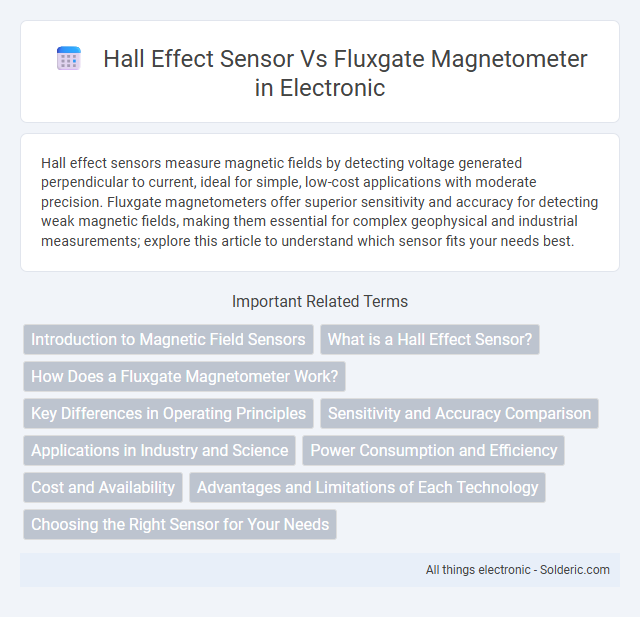Hall effect sensors measure magnetic fields by detecting voltage generated perpendicular to current, ideal for simple, low-cost applications with moderate precision. Fluxgate magnetometers offer superior sensitivity and accuracy for detecting weak magnetic fields, making them essential for complex geophysical and industrial measurements; explore this article to understand which sensor fits your needs best.
Comparison Table
| Feature | Hall Effect Sensor | Fluxgate Magnetometer |
|---|---|---|
| Principle | Voltage generated across conductor in magnetic field | Magnetic field modulation using ferromagnetic core |
| Measurement Range | Up to several tesla | NanoTesla to microTesla (high sensitivity) |
| Sensitivity | Low to moderate | High sensitivity |
| Accuracy | Moderate | High |
| Size | Compact, integrated circuits | Larger, bulkier design |
| Cost | Low cost | Higher cost |
| Power Consumption | Low | Higher power consumption |
| Applications | Position sensing, current sensing, speed detection | Geophysical surveys, space magnetometry, scientific research |
| Temperature Stability | Moderate | High |
Introduction to Magnetic Field Sensors
Magnetic field sensors detect and measure magnetic fields, essential in applications like navigation, industrial monitoring, and electronics. Hall effect sensors generate voltage proportional to magnetic field strength by exploiting the Hall effect in conductors, offering simplicity and cost-effectiveness for moderate field measurements. Fluxgate magnetometers use ferromagnetic cores and feedback loops to achieve high sensitivity and precision in detecting weak magnetic fields, ideal for geophysical and space research, enabling your projects to choose the right sensor based on accuracy and application needs.
What is a Hall Effect Sensor?
A Hall Effect sensor detects magnetic fields by measuring the voltage generated perpendicular to an electric current in a conductor immersed in a magnetic field, enabling precise position or speed sensing. Unlike fluxgate magnetometers, which measure magnetic flux through coil cores for high-sensitivity applications, Hall Effect sensors are typically more compact, cost-effective, and suitable for detecting steady-state or dynamic fields in automotive and industrial systems. Your choice depends on whether you need a robust, low-cost solution for magnetic detection or a highly sensitive instrument for detailed magnetic field measurements.
How Does a Fluxgate Magnetometer Work?
A fluxgate magnetometer operates by detecting changes in magnetic fields using a core wrapped with primary and secondary coils; the primary coil is driven with an alternating current that magnetizes the core, and the secondary coil senses induced voltages caused by external magnetic fields influencing the core's saturation. This sensor excels in measuring low-intensity magnetic fields with high precision and stability, making it ideal for geophysical surveys and navigation applications. Compared to Hall effect sensors, fluxgate magnetometers offer greater sensitivity and accuracy for detecting weak magnetic variations that your project may require.
Key Differences in Operating Principles
Hall effect sensors detect magnetic fields by measuring voltage generated across a conductor when exposed to a perpendicular magnetic field, relying on the Lorentz force affecting charge carriers. Fluxgate magnetometers operate by using ferromagnetic cores driven to saturation by an alternating magnetic field, detecting minute changes in magnetic flux via induction. The precise measurement capabilities of fluxgate magnetometers contrast with the simpler, lower-cost design of Hall effect sensors, making each suitable for different applications requiring varying sensitivity and complexity.
Sensitivity and Accuracy Comparison
Fluxgate magnetometers offer significantly higher sensitivity and accuracy than Hall effect sensors, capable of detecting magnetic fields down to the picotesla range. Hall effect sensors typically operate effectively in the microtesla range, providing less precise measurements suitable for general magnetic field detection. Fluxgate sensors use a core saturation method to minimize noise and improve resolution, making them ideal for applications requiring precise geomagnetic field measurements.
Applications in Industry and Science
Hall effect sensors are widely used in industrial applications for position sensing, speed detection, and current measurement due to their robust design and cost-effectiveness. Fluxgate magnetometers offer high sensitivity and accuracy, making them ideal for scientific research such as geomagnetic field mapping and space exploration. Your choice depends on the required precision and environmental conditions of the application.
Power Consumption and Efficiency
Hall effect sensors typically consume less power than fluxgate magnetometers, making them more energy-efficient for battery-operated and portable devices. Fluxgate magnetometers, while offering higher sensitivity and accuracy, require complex excitation and processing circuits that result in increased power consumption. Your choice depends on whether power efficiency or measurement precision is the priority for your specific application.
Cost and Availability
Hall effect sensors are generally more cost-effective and widely available due to their simple construction and extensive use in various consumer and industrial applications. Fluxgate magnetometers tend to be more expensive and less commonly available, primarily because of their complex design and specialized usage in high-precision magnetic field measurements. The affordability and accessibility of Hall effect sensors make them a popular choice for mass-market products requiring basic magnetic sensing capabilities.
Advantages and Limitations of Each Technology
Hall effect sensors offer compact size, low cost, and simple integration for measuring magnetic fields, making them suitable for consumer electronics and automotive applications, but they suffer from lower sensitivity and accuracy in weak magnetic fields. Fluxgate magnetometers provide highly precise and stable measurements of low-intensity magnetic fields, ideal for geophysical surveys and scientific research, but they are more complex, power-hungry, and expensive. Your choice depends on the required sensitivity, environmental conditions, and budget constraints, balancing the ease of use of Hall sensors against the superior precision of fluxgate magnetometers.
Choosing the Right Sensor for Your Needs
Hall effect sensors provide a cost-effective solution for detecting magnetic fields with moderate sensitivity and are ideal for applications requiring simple, robust, and compact devices. Fluxgate magnetometers excel in precision and can measure extremely weak magnetic fields with high accuracy, making them suitable for geophysical surveys, navigation, and scientific research. Your choice depends on factors like required sensitivity, measurement range, size constraints, and budget.
Hall effect sensor vs fluxgate magnetometer Infographic

 solderic.com
solderic.com